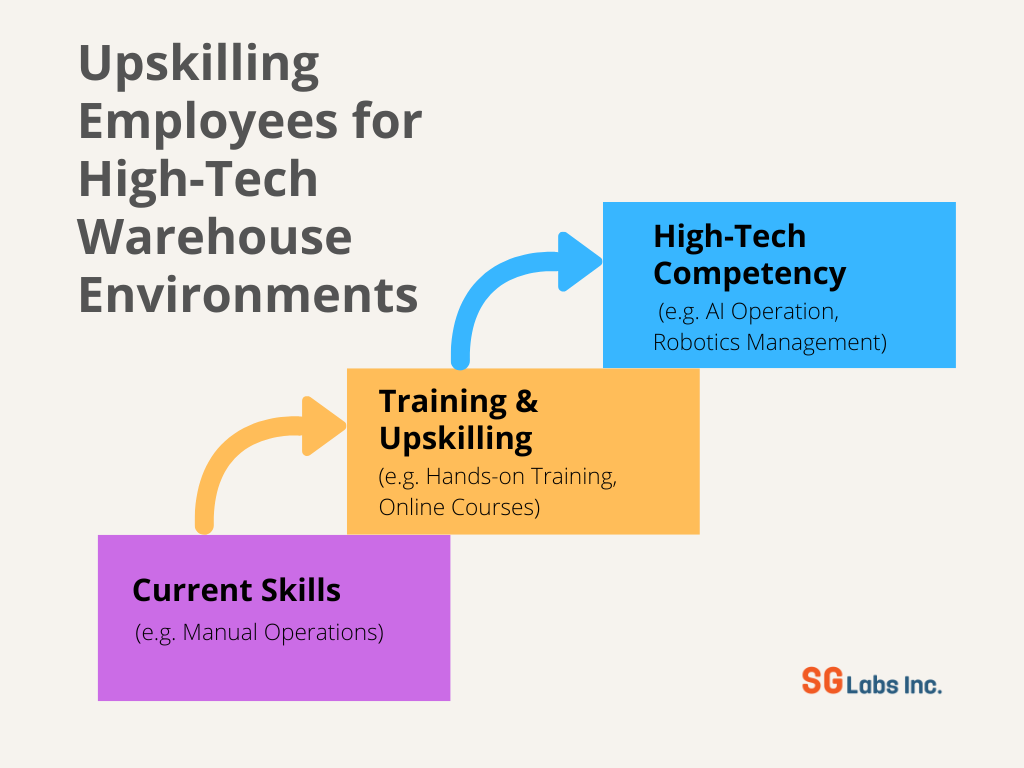From Manual to Machine: How to Upskill Employees for Tomorrow’s Warehouse

As warehouses across the world continue to adopt advanced technologies such as AI, robotics, and machine vision, the role of the warehouse worker is evolving. No longer confined to manual tasks, today’s warehouse employees are increasingly required to interact with sophisticated systems, manage automated processes, and make data-driven decisions. For companies looking to stay competitive in this rapidly changing landscape, training and upskilling employees for high-tech warehouse environments is not just a nice-to-have—it’s a necessity.
Why Upskilling is Crucial in Modern Warehousing
The integration of high-tech solutions into warehouse operations offers numerous benefits, including improved efficiency, accuracy, and safety. However, to fully realize these benefits, it’s essential that the workforce is adequately trained to operate and maintain these technologies.
1. Bridging the Skills Gap
With the rapid advancement of technology, a significant skills gap has emerged in the logistics and warehousing sector. Employees who have traditionally performed manual tasks may find themselves needing to understand and operate complex software, manage automated equipment, and interpret data analytics. Bridging this gap requires a concerted effort in training and education.
Investing in upskilling programs helps employees develop the necessary competencies to work with new technologies. This not only improves productivity but also boosts employee morale, as workers feel more confident and capable in their roles.
2. Enhancing Safety Standards
Safety is a top priority in any warehouse environment. As automation and robotics become more prevalent, the nature of workplace hazards is shifting. Employees need to be trained on how to safely interact with automated systems, understand emergency protocols, and troubleshoot issues that may arise with high-tech equipment.
Upskilling programs that focus on safety training ensure that workers are not only protected but also prepared to respond effectively to any potential risks. This proactive approach to safety training can significantly reduce workplace accidents and improve overall operational safety.
3. Improving Operational Efficiency
When employees are well-trained in the use of high-tech systems, operational efficiency improves dramatically. Workers who understand how to optimize the use of AI-driven tools, robotics, and machine vision can execute tasks more quickly and accurately. This reduces downtime, minimizes errors, and streamlines the workflow.
Moreover, upskilled employees are better equipped to identify areas for improvement within the warehouse, contributing to continuous operational enhancement and innovation.
Effective Strategies for Upskilling in High-Tech Warehouses
To successfully upskill employees, companies must implement structured and ongoing training programs that address both the current and future needs of the warehouse environment. Here are some strategies to consider:
1. Blended Learning Approaches
Combining online courses, hands-on training, and on-the-job coaching provides a comprehensive learning experience. Online platforms can deliver theoretical knowledge about new technologies, while hands-on training and coaching allow employees to apply what they’ve learned in a practical setting.
2. Cross-Training
Cross-training employees on different systems and processes within the warehouse ensures flexibility and resilience. Workers who are familiar with multiple aspects of the operation can step in when needed, reducing dependency on a single skill set and promoting a more adaptable workforce.
3. Mentorship Programs
Pairing less experienced employees with seasoned workers or supervisors can facilitate knowledge transfer and provide real-time guidance. Mentorship programs foster a collaborative learning environment and help employees feel supported as they transition into high-tech roles.
4. Continuous Learning Culture
Technology in the warehouse is constantly evolving, so it’s important to cultivate a culture of continuous learning. Encourage employees to stay curious and engage with new tools and technologies regularly. Offering incentives for ongoing education and certifications can further motivate employees to stay ahead of the curve.
The Role of Leadership in Employee Upskilling
Leadership plays a crucial role in the success of upskilling initiatives. Managers and supervisors must be committed to providing the resources, time, and support necessary for effective training. This includes recognizing the importance of employee development as a key factor in the company’s long-term success.
Leaders should also be transparent about the impact of new technologies on job roles, setting clear expectations and providing reassurance that upskilling is an opportunity for growth, not a threat to job security.
Conclusion
As the logistics and warehousing industry continues to evolve, the need for a skilled, adaptable workforce becomes more critical. By investing in training and upskilling programs, companies can empower their employees to thrive in high-tech environments, ensuring both operational success and employee satisfaction.
At QicVision, we’re committed to helping companies navigate this transition by offering cutting-edge solutions that enhance both technology and talent. By embracing a culture of continuous learning and providing the tools employees need to succeed, companies can remain competitive in an increasingly automated world.
